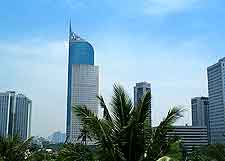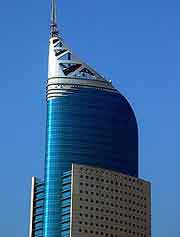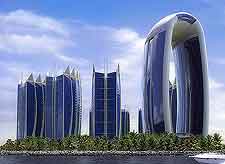Jakarta History Facts and Timeline
(Jakarta, Java, Indonesia)

Jakarta, the capital of Indonesia, has always played an important role in the development of Java, the island on which it sits.
Since the 5th century it has been a main stop along the shipping trade routes of Asia, changing hands every few centuries as Islamic sultans moved in, followed by European colonists and finally a home-grown independence movement for Indonesian nationalism. Jakarta's history has always been interwoven with the evolution of Indonesia and continues to shape its future as the capital of the nation.
Sundanese Kingdom
Long before Islam arrived in the region, Jakarta was part of one of the oldest and most powerful Hindu kingdoms in Indonesia. From the 4th century onwards, the Tarumanagara people controlled the perfectly situated port area where Jakarta now stands.
As this kingdom fell into decline in the late 7th century, its territory was absorbed into the larger Kingdom of Sunda, which reigned over the area until the 16th century. During these prosperous centuries, the port town was an important component in the massive Srivijaya maritime empire that controlled the Malay Peninsula, Sumatra and Western Java (Sunda).

European Arrivals
The first Europeans began to arrive in the 1500s, looking for a sea route for the trade in spices. Several Portuguese ships from Malacca, Malaysia, landed in Jakarta in 1513 and the Kingdom of Sunda was receptive to their proposals of trade. They signed a treaty with the Portuguese that allowed the foreigners to build a defensive port as protection against the increasingly powerful Sultanate of Demak ruling Central Java.
The tactic failed, however, and in 1527 a Javanese general from Demak sacked the city, drove out the Portuguese and renamed the port town Jayakarta. From then on, Jakarta was a fiefdom of the Sultanate of Banten, who had control over the Demak Sultanate. Of note, the name came from Prince Jayawikarta of Banten.
Relations with the Dutch
The Sultanate of Banten had developed a reciprocal relationship with the Dutch colonial powers of the time. Prince Jayawikarta invited Dutch ships to dock here in 1596. A few years later, in 1602, ships from the British East India Company were also permitted to dock here. The British loved the location of Jakarta so much that they were allowed to build a trading post here, and this remained the British centre of Indonesian trade until the year of 1682.
Of course, the Dutch and English were fierce rivals. When Prince Jayawikarta played them off against each other, the Dutch got angry and relations devolved into a small war that resulted in the defeat of the British and the subsequent removal of Prince Jayawikarta. The Dutch renamed the city Batavia in 1619 to celebrate their victory.

A Commercial Hub
As the capital of the Dutch colonies, Batavia boomed almost overnight into a major port city. Chinese and Indonesian immigrants flooded in, straining resources and relations. The 1700s and 1800s were rather turbulent times in the city, as Jakarta's history was being forged by Dutch policymaking that didn't always take the interests of the local inhabitants into account.
Rebellion and Independence
During WWII, the history of Indonesia took a significant turn when nationalists asked for help from the occupying Japanese forces, wishing to drive the Dutch out once and for all. After their victory in 1942, they renamed the city Jakarta. When the Japanese lost WWII, the Indonesian Republicans moved their base from Allied-occupied Jakarta to a new capital in Yogyakarta.
When Indonesia finally gained independence in 1950, Jakarta was named the capital. The founding president, Sukarno, wanted to transform Jakarta into a world-class city and instigated massive infrastructure projects. Many of these monuments, such as the National Monument, South-East Asia's largest mosque and the Hotel Indonesia, still stand in the capital today.
 Jakarta, the capital of Indonesia, has always played an important role in the development of Java, the island on which it sits.
Jakarta, the capital of Indonesia, has always played an important role in the development of Java, the island on which it sits.
